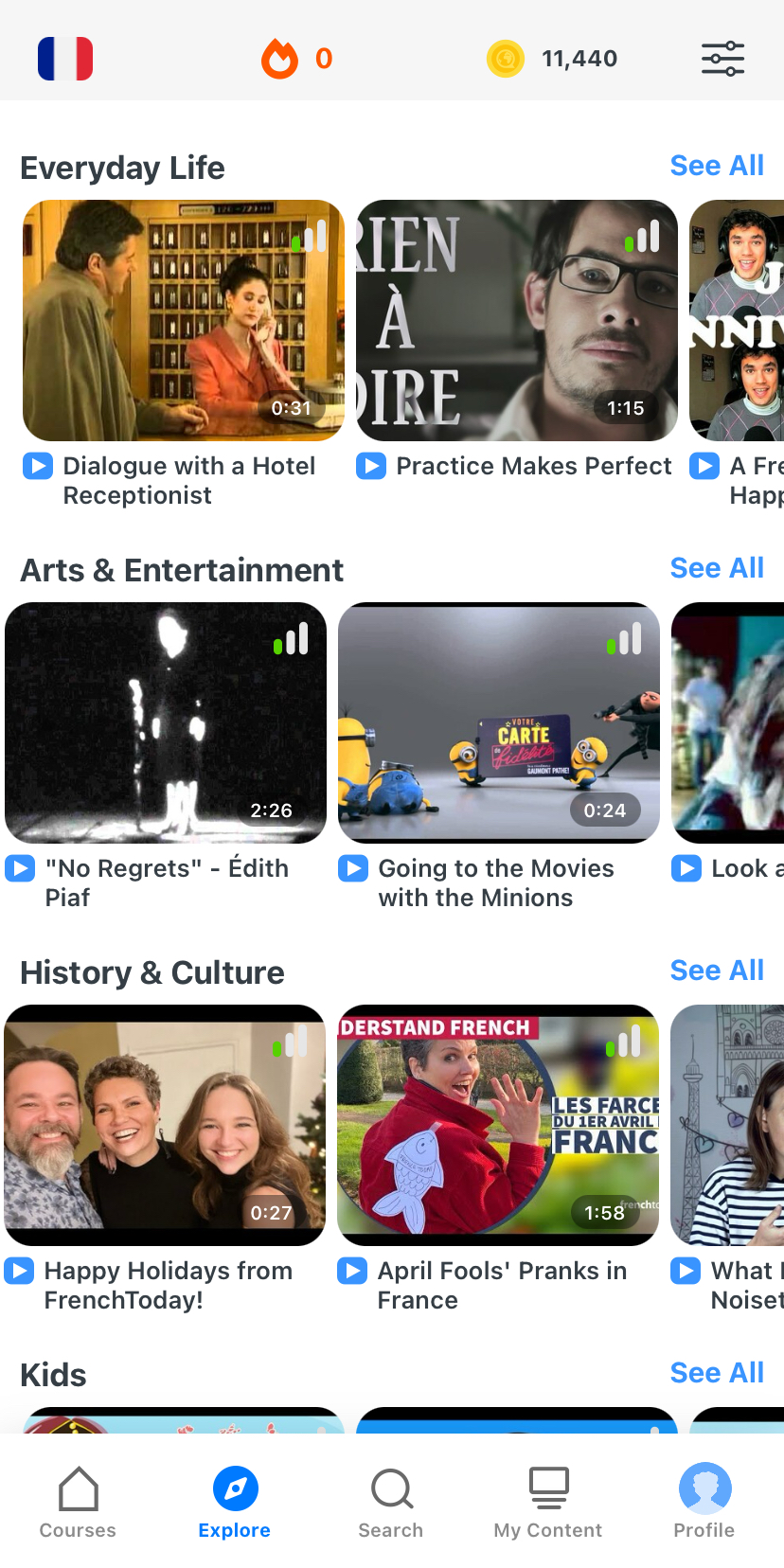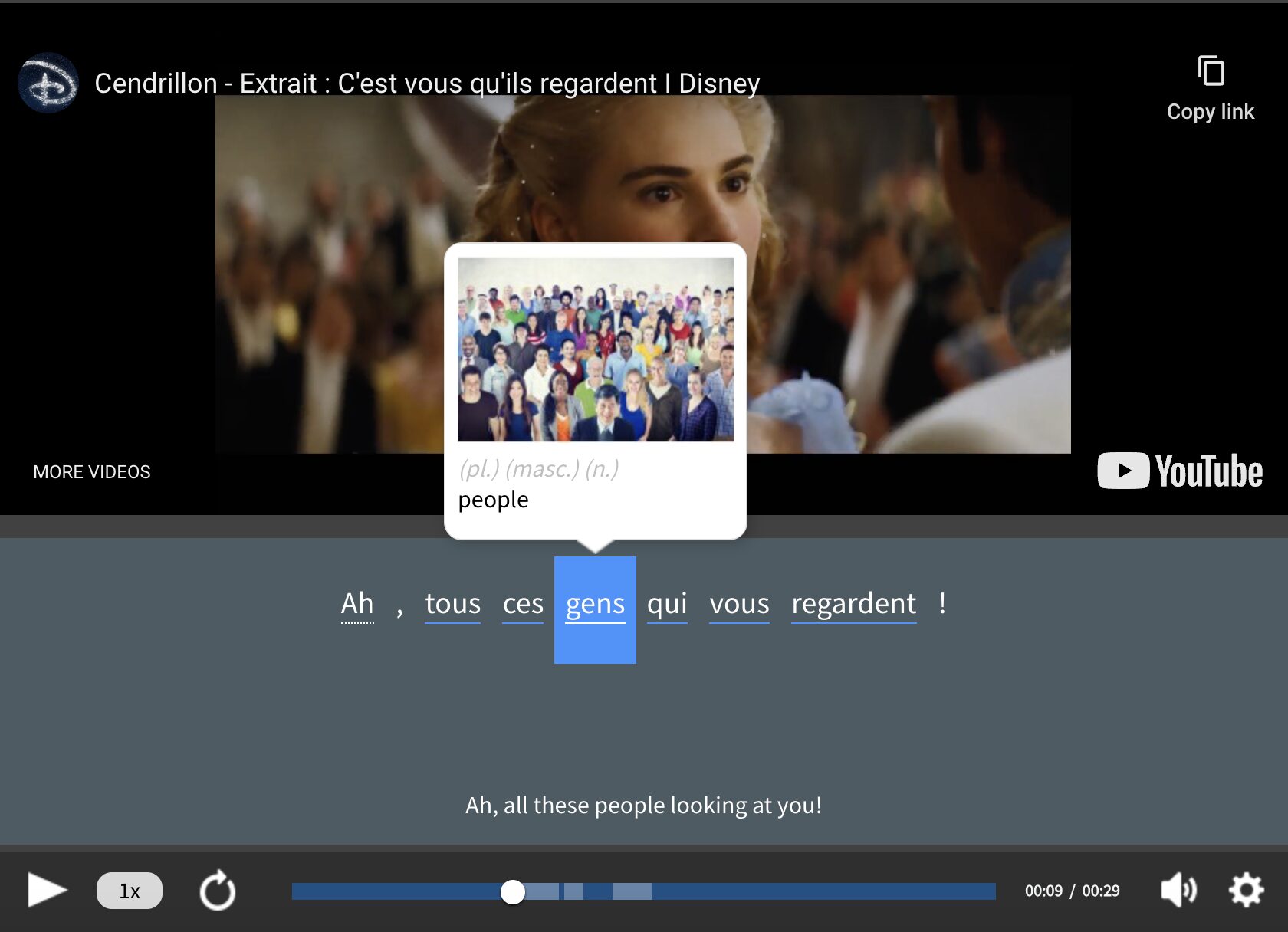Contents
- 1. “8 femmes” (“8 Women”)
- 2. “Un conte de Noël” (“A Christmas Tale”)
- 3. “Ma nuit chez Maud” (“My Night at Maud’s”)
- 4. “Mon oncle Antoine” (“My Uncle Antoine”)
- 5. “Les Parapluies de Cherbourg” (“The Umbrellas of Cherbourg”)
- 6. “Le Père Noël est une ordure” (“Santa Claus Is a Stinker”)
- 7. “L’assassinat du Père Noël“ (“Who Killed Santa Claus?”)
- 8. “Le Père Noël a les yeux bleus“ (“Santa Claus Has Blue Eyes”)
- 9. “The Christmas Calendar”
- 10. “L’Arbre de Noël“ (“The Christmas Tree”)
- 11. “Joyeux Noel“ (“Merry Christmas”)
- 12. “The Dog Who Saved Christmas Vacation“
- 13. “Ma saison préférée“ (“My Favorite Season”)
- 14. “Y’aura-t-il de la neige à Noël?“ (“Will It Snow for Christmas?”)
- Why Learn with French Christmas Movies
- And One More Thing...
14 Festive French Christmas Movies

Whether you’re already in the process of picking up the language, contemplating re-starting after a prolonged break or just an unassuming Francophile poking around for a culture buzz, the festive season is the perfect time to brush up your French language skills!
In this post, you’ll get a list of 14 excellent French Christmas movies you can add to your watchlist.
Download: This blog post is available as a convenient and portable PDF that you can take anywhere. Click here to get a copy. (Download)
1. “8 femmes” (“8 Women”)
Watch: Amazon Prime
Year: 2002
Genre: Comedy/Crime/Musical
During a Christmas get-together, the man of the family is found dead with a knife in his back. An Agatha Christie-esque mystery unfolds among the eight women in the house, who set about analyzing each other to try to determine who the killer is. In the process, they take turns breaking into song and we learn a little more about each of them.
If you’re a beginner, you can benefit from “8 femmes” by trying to catch single words and shorter lines of dialogue. In general, the dialogue tends to be clear, even when shouted, although the speed changes frequently depending on who’s talking or what’s going on.
Many of the songs in the movie contain grammar constructions that will be way over a beginner’s head.
Intermediate learners can use this movie to get comfortable with verbs that take être (to be) as the helping/auxiliary verb in the passé composé (compound past).
“8 femmes” takes place in a physical house, and since there are all kinds of accusations and discussions about comings and goings during the night, you can imagine how this quickly covers verbs like sortir (to go out, leave), monter (to go up), descendre (to go down) and so on. If you’re rusty, you can take this BuzzFeed quiz to refresh.
Advanced learners can use this film to work on their general listening skills by trying dictation and translation exercises with the songs and spoken content.
One good opportunity is when Pierrette, the victim’s sister, reads a letter out loud. Try transcribing a short part, then translate it into English and check your version against the subtitles.
2. “Un conte de Noël” (“A Christmas Tale”)
Watch: Amazon Prime
Year: 2008
Genre: Comedy/Drama
A family split apart by a woman who has refused to acknowledge her brother’s existence for years is thrown back together when the matriarch, Junot, finds she needs a bone-marrow transplant. The search for a donor becomes tangled up with old resentments, tense relationships and (of course) Christmas.
As with most movies, a lot of the French in this movie will be too advanced for beginners to understand, but it features a long running time with a lot of different speakers (including a couple of totally adorable kids), so it’s good for getting in listening practice regardless.
A good exercise you can do with this one is to practice getting down all your French family vocabulary. Take note of any family-related words you hear, especially those that describe people’s relationships to each other, such as mère (mother), fils (son) or neveu (nephew). Try to figure out what everyone’s relationship to each other is and write short sentences explaining these relationships.
If you’re far along enough that you’ve gotten to the passé simple (past simple), you can pay attention to how it’s used along with the imparfait (imperfect) in the intro of this movie, which explains the family history in a storybook format.
The movie continues with a playful sense of artifice that isolates portions of audio, such as narration or a scene in which Henri, the estranged brother, is shown reciting a letter out loud that he wrote to his sister. Isolated monologues like these are just generally great for doing dictation exercises (even if you only get part of them).
This movie is also good for picking up bits of medical vocabulary, and between this one and the next film, you could learn some vocab for talking about or doing math in French, too (if you happen to be into that kind of thing).
3. “Ma nuit chez Maud” (“My Night at Maud’s”)
Watch: Amazon Prime
Year: 1969
Genre: Comedy/Drama/Romance
Jean-Louis, a self-described Catholic who dabbles in mathematics and philosophy, runs into an old friend, Vidal, who he invites to attend Christmas Eve mass with him. They later visit a friend of Vidal’s, Maud, at her apartment. A discussion ensues surrounding love, marriage, religion and philosophy, and an attraction seems to grow between Jean-Louis and Maud as the night moves on.
Since this movie involves a lot of terminology surrounding philosophy and religion, it’s good for trying to pick out new pronunciations of words that are already somewhat familiar to you from English.
For example, the word verglas comes up several times. This word refers to ice in the specific sense of a sheet of (black) ice that you might encounter on a road in winter (it has nothing to do with what’s floating in your glass of Perrier). At first it’s just part of a casual conversation (albeit with a slight sense of foreboding), but it becomes more significant later on.
This movie also contains an opportunity to hear The Lord’s Prayer in French.
Whatever your feelings about religion may be, there’s a good chance that you’ve heard this in English somewhere at some point in your life (even if only in other movies), so it’s a good reference point. You may also find it interesting to note—if you don’t know already—that in prayer, it’s appropriate to tutoyer (say “tu” to) God.
4. “Mon oncle Antoine” (“My Uncle Antoine”)
Watch: YouTube
Year: 1971
Genre: Drama
A teenage boy in a Quebec mining town, whose uncle owns the local general store and undertaking business, begins to comprehend the major realities of adult life. An interwoven subplot involving a miner who, fed up with his English-speaking boss, leaves his family temporarily to work elsewhere, meets up with the main storyline in an unexpected way.
The nice thing about this film is that the dialogue is somewhat spread out. There’s quite a bit of it, but it’s not just non-stop talking, and a lot of what’s going on can be guessed from context.
One thing beginners can do here is to focus on learning Christmas vocabulary by paying attention to the various decorations and holiday items mentioned, such as des cadeaux (gifts), la crèche (the crèche/Nativity scene), le sapin (the Christmas tree), des cloches (bells) and des jouets (toys).
If you’ve been learning French for a while but haven’t gotten into any linguistic or cultural elements of Quebec French, here’s a good resource to start.
The extended scene in the store is also a good place for more advanced learners to both listen to the dialect and work on general listening.
There’s one scene in which the main character’s aunt sings an old folk song of which you can find many different versions online.
Many of them use older spellings and language, and you may not find any that match up perfectly with the way the song is sung in the movie, but comparing them can be interesting and good for your language skills.
5. “Les Parapluies de Cherbourg” (“The Umbrellas of Cherbourg”)
Watch: Amazon Prime
Year: 1964
Genre: Drama/Musical/Romance
A young couple in love who plan to marry are separated by the Algerian war and, through other twists of fate and circumstance, wind up marrying different people.
When I say this is a musical, you might think I mean that it’s broken up into segments of dialogue and song like “8 femmes.” In fact, it’s a film in which everyone simply sings instead of talking. The dialogue has a kind of rhythm and occasionally rhymes, but doesn’t follow any clear pattern.
Whatever stage you’re at in your French-learning journey, you may have had varying degrees of success listening to audio material in the background. This is a good one to try doing that with, because even if you’re at a lower-intermediate level, you may still be able to catch a lot of the sung dialogue in this film.
The sung words can almost provide their own moment-by-moment context, as the characters discuss everyday situations like making plans, passing time and obligations.
Try watching the movie once, with or without subtitles, and then try playing it later while you’re doing something else low-pressure in French (like browsing newspaper articles online). As the words aren’t actually arranged into complete songs, you may find that separate lines stand out and worm their way into your consciousness more easily.
6. “Le Père Noël est une ordure” (“Santa Claus Is a Stinker”)
Watch: Amazon
Year: 1982
Genre: Comedy
Two people working for a suicide hotline over the holidays find their space and peace of mind disturbed by the comings and goings of a varied bunch of characters. Hilarity (and vulgarity) ensues.
As a beginner, you can take advantage of this movie by trying to keep up with various characters’ tics and habits, as well as repeating jokes.
For example, Pierre, one of the main characters who works at the hotline, has a very distinctive way of saying “C’est cela” (That’s right). This has become a sort of inside joke among people who have seen the movie.
This is a great movie for more advanced learners to practice their listening and expand their cultural knowledge at the same time.
The thing is, there are those movies that are good for cultural learning because they show an important point in a nation’s history, or maybe an insight into how “real people” actually live. This is not that (hopefully), but it is an incredibly quotable movie that has made its way into the French consciousness.
7. “L’assassinat du Père Noël“ (“Who Killed Santa Claus?”)
Watch: Amazon, Amazon Prime
Year: 1941
Genre: Drama/Comedy/Mystery
A globe-painter in a French town dresses up as Santa Claus to make rounds on Christmas Eve. In the meantime, his romantic-minded daughter Catherine is lovestruck, the object of her affections being a baron who has returned to the area recently. Later that night, a man dressed as Santa Claus is found dead and panic ensues.
Despite this being a very old film, the sound quality is pretty good and it’s surprisingly easy to understand at least some of the characters.
For example, the baron, who is shown interacting with others in a more removed, formal way (at least toward the beginning of the film) and throwing around booming commands like “Asseyez-vous” (Sit down), is very easy to follow.
Some of the conversations between kids, including those featuring a bedridden young boy named Christian, also use fairly clear and simple language.
In general, the creepier or more helpless a character is supposed to be at any given moment, the slower their speech is and the easier they are to understand. Adjust your attention accordingly.
With dramatic musical cues, expressive dialogue and a plot that proceeds in a linear (if not expected) manner, this is a great film for learning from context and rewatching.
A lot of the dialogue takes place between just two characters, or smaller groups of characters in otherwise silent rooms, which makes for a comfortable learning atmosphere.
This movie is based on a book by Pierre Véry, which you can check out as a supplement if you’re interested.
8. “Le Père Noël a les yeux bleus“ (“Santa Claus Has Blue Eyes”)
Watch: Amazon Prime
Year: 1966
Genre: Drama
A guy who has little luck with girls or money takes a job working as Santa Claus during the holiday season and finds that while in costume, it’s much easier for him to woo women. However, this doesn’t exactly solve all his problems.
As a beginner, don’t give yourself too much grief for not being able to understand a good portion of the dialogue and the narration in this film right off.
Because of Léaud’s crisp, clipped way of speaking, it might seem like he should be easier to understand, but his narrative bits use several different tenses and are spoken pretty quickly.
Listen for those moments when the dialogue slows down and you can catch simple conversational phrases like “Ça va ? On y va ?” (“How’s it going? Shall we?”). There are actually quite a few of these—you just have to be patient.
If you’re a more advanced learner, on the other hand, the contrast between dialogue and narration in this film makes for a manageable chunk of learning material.
Try to pick out parts of the narration that interest you and write them down, paying special attention to verb tenses and how they’re being used together. The imparfait is employed quite a bit in these parts to convey a general state of things.
Again, Léaud’s character does speak very quickly sometimes, but the way he talks is fairly consistent. If you give yourself the time to re-listen to parts you miss, you’ll probably do much better the second time around.
9. “The Christmas Calendar”
Watch: Amazon Prime
Year: 2017
Genre: Comedy/Mystery/Romance
Emily, a struggling baker in a small town, discovers an old advent calendar that seems to have the power to predict her future and becomes obsessed with finding out the identity of the sender.
For a language learner, this film provides a delightful mix of everyday conversations and festive vocabulary. If you’re a beginner, you can focus on common expressions related to the holiday season, such as “Joyeux Noël” (Merry Christmas) and “cadeau” (gift).
Intermediate learners can pay attention to the characters’ interactions. It’s a perfect opportunity to practice your listening skills in various social situations. If you’re an advanced learner, challenge yourself to transcribe and translate key scenes, especially those involving the magical elements of the calendar.
10. “L’Arbre de Noël“ (“The Christmas Tree”)
Watch: Amazon, Amazon Prime
Year: 1969
Genre: Drama
Pascal, a ten-year-old boy, spends his holidays with his wealthy father, Laurent Segur, following his mother’s death. A plane crash off the shores of Corsica exposes Pascal to a nuclear weapon, giving him only six months to live. It’s a touching tale of family bonds during the Christmas season. The film explores themes of love, forgiveness, and the magic of the holidays.
For beginners, this movie offers clear dialogues so it’s easy to grasp basic vocabulary related to family dynamics and holiday traditions. Intermediate learners can get a better understanding of emotional expressions and nuanced interactions.
Advanced learners can delve into the deeper layers of the narrative, focusing on the complex relationships portrayed and exploring the film’s cultural significance.
11. “Joyeux Noel“ (“Merry Christmas”)
Watch: Amazon Prime, Apple TV
Year: 2005
Genre: Drama/History/Music
A drama that takes us back to Christmas Eve during World War I when the Germans, French, and Scottish fraternize and get to know the men who live on the opposite side of a brutal war. This film provides an opportunity for language learners to explore formal and informal language used in war times.
Beginners can concentrate on common phrases related to greetings, while intermediate and advanced learners can analyze the historical nuances of the film, engaging in discussions about war, peace, and the human experience.
12. “The Dog Who Saved Christmas Vacation“
Watch: Amazon Prime
Year: 2010
Genre: Drama/Comedy/Family
It is Christmas vacation time for the Bannister family along with the wonder dog Zeus – former K-9 police hero. But when they arrive at a beautiful Rocky Mountain resort, their plans have a detour.
For beginners, this film is perfect for language learning. It features simple dialogues and humorous situations. Intermediate learners can focus on understanding the characters’ motivations and reactions, so you can get better at following narratives. If you’re an advanced learner, you’ll have a blast exploring humorous wordplays and idiomatic expressions within the context of a festive family comedy.
13. “Ma saison préférée“ (“My Favorite Season”)
Watch: Amazon Prime
Year: 1993
Genre: Drama/Romance
Berthe, an elderly woman, moves from her house to live with her daughter Emilie. The siblings, Emilie and Antoine, who have been estranged for three years, reunite for Christmas. As they gather, memories resurface, unraveling Berthe’s life journey and exploring the complex dynamics between Emilie and Antoine.
This drama provides language learners with rich dialogues that explore themes of love, loss, and reconciliation. Beginners can concentrate on straightforward conversations, picking up essential vocabulary, while intermediate and advanced learners may challenge themselves by understanding the characters’ perspectives and motivations.
14. “Y’aura-t-il de la neige à Noël?“ (“Will It Snow for Christmas?”)
Watch: Amazon Prime
Year: 1996
Genre: Drama
In Southern France, a woman and her seven children strive for a happy life on a farm. However, their joy is overshadowed by the oppressive and egotistic farm owner. Treated as property, the family endures harsh labor and is denied the freedom to leave.
Beginners can focus on everyday conversations in a rural setting, picking up vocabulary related to nature and family life.
Advanced learners can analyze the film’s cultural and historical context, engaging in discussions about societal expectations and the complexity of familial relationships.
Why Learn with French Christmas Movies
- Get a head start on your New Year’s resolution (of finally learning French). New Year’s is approaching fast, and you need an exciting goal to keep you motivated through the bleakness that hits come January. Movies aren’t just a good way to learn a language, they’re a reliable indoor activity for winter and a core part of French culture. They can help you get off to a great start and into a healthy, fulfilling relationship with the language.
- Take advantage of time off work or school to buckle down and get ahead. For many, the holidays are a time to relax and spend time with loved ones, but they’re also a convenient break in everyday routine. If you’re off from work or school, it’s the perfect time to start building up a French knowledge base and experimenting with a learning routine.
Even if you don’t have a break in your schedule—heck, even if you’re working on Christmas Day (yay, overtime!) or don’t celebrate it—the end of the year is still a logical time for self-reflection and setting off in new directions.
- Lessen holiday stress by watching movies about it (in French!). If you suffer from holiday stress, watching people freak out in French movies about Christmas will remind you that you’re not alone, while at the same time making the experience seem more distant (if you’re not actually in a French-speaking country).
- Grab some you-time during family get-togethers by saying you need to practice your French (subtitle-free). If you’re still feeling stressed out, or if you’re just yearning to escape getting grilled by extended family on the latest details of your life, you can slip away from non-French-speakers by putting on a French movie without subtitles. Of course, if subtitles are part of your learning plan, you can turn them back on after everyone leaves.
- Christmas itself is a cross-cultural reference point you can use to gain footing in the language. But enough with the non-social behavior! Let’s think about what connects us. No matter where you are while you’re reading this, and whether or not you celebrate Christmas yourself, you’re likely highly aware of Christmas season culture.
For French learners, this means an opportunity to build up vocabulary in familiar areas, to observe differences and similarities in tradition, and maybe even to feel a little more at home with Francophone language and culture. So let’s get comfortable!
So if you find yourself with some time to spare over the holidays, don’t just let it slip away. Take advantage of it.
Curl up with one of the above movies, get comfortable and get a head start on next year’s French!
Download: This blog post is available as a convenient and portable PDF that you can take anywhere. Click here to get a copy. (Download)
And One More Thing...
If you like learning French at your own pace and from the comfort of your device, I have to tell you about FluentU.
FluentU makes it easier (and way more fun) to learn French by making real content like movies and series accessible to learners. You can check out FluentU's curated video library, or bring our learning tools directly to Netflix or YouTube with the FluentU Chrome extension.
One of the features I find most helpful is the interactive captions—you can tap on any word to see its meaning, an image, pronunciation, and other examples from different contexts. It’s a great way to pick up French vocab without having to pause and look things up separately.
FluentU also helps reinforce what you’ve learned with personalized quizzes. You can swipe through extra examples and complete engaging exercises that adapt to your progress. You'll get extra practice with the words you find more challenging and even be reminded you when it’s time to review!
You can use FluentU on your computer, tablet, or phone with our app for Apple or Android devices. Click here to take advantage of our current sale! (Expires at the end of this month.)










